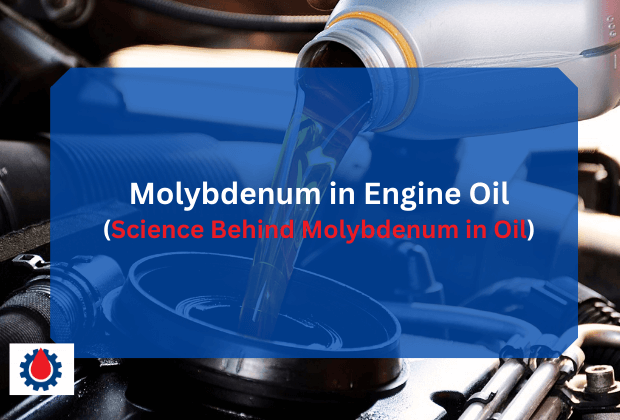Molybdenum, a silvery-white metal, is increasingly being used as an additive in engine oils due to its unique properties. It’s primarily known for its ability to reduce friction, which helps engines run more efficiently and last longer.
This post will explore why molybdenum is added to engine oil, its benefits, how it works, and its role in modern engine technology. Let’s jump in.

Molybdenum in Engine Oil
One of molybdenum’s key advantages in engine oil is its ability to significantly lower friction between moving parts. Internal combustion engines rely on constant movement between metal components, such as pistons, camshafts, and bearings.
Without sufficient lubrication, these parts can wear down quickly, leading to engine failure.
Molybdenum works by forming a thin, protective film on metal surfaces within the engine. This film reduces the direct metal-to-metal contact, allowing the parts to slide more smoothly and reducing overall friction. Less friction means reduced wear, lower heat generation, and improved engine efficiency.
Read Engine Oil Change Soon(Here’s How Long You Can REALLY Wait!)
Benefits of Molybdenum in Engine Oil
1. Improved Fuel Efficiency
Reduced friction leads to better fuel efficiency. When the engine doesn’t have to work as hard to overcome internal resistance, it can run more smoothly, using less fuel in the process.
Studies have shown that adding molybdenum to engine oil can lead to noticeable improvements in fuel consumption, particularly in high-mileage vehicles and under heavy load conditions.
2. Enhanced Wear Protection
Over time, engines are subjected to wear, especially under harsh conditions such as high speeds, heavy loads, and extreme temperatures. Molybdenum provides an extra layer of protection, helping to extend the life of critical engine components.
This is especially important for engines with turbochargers or those operating under high stress, where wear rates can be much higher.
3. Temperature Stability
Molybdenum compounds are highly stable at elevated temperatures, which is crucial in high-performance engines. When engines run hot, standard lubricants can break down, losing their protective qualities. Molybdenum’s heat resistance ensures that its friction-reducing properties remain effective, even in high-temperature environments.
4. Reduced Oxidation
Molybdenum additives can also help prevent oil oxidation. Oxidation occurs when engine oil reacts with oxygen, leading to sludge formation and a decrease in oil performance.
By slowing the oxidation process, molybdenum helps maintain the oil’s viscosity and protective qualities for a longer period, extending the oil change intervals and enhancing engine longevity.
5. Anti-Corrosion Properties
Molybdenum disulfide is also known for its anti-corrosion benefits. Engines, especially those subjected to long periods of inactivity or harsh operating environments, are susceptible to rust and corrosion.
By forming a protective layer on metal surfaces, molybdenum helps shield engine components from the harmful effects of moisture and oxidation.
Read How Tight Does an Oil Filter Need To Be(Avoid This Mistake)
What is Molybdenum?
Molybdenum (Mo) is a transition metal found in nature and widely used in industrial applications. It’s prized for its strength, heat resistance, and ability to form compounds that help reduce wear. In engine oil formulations, molybdenum is commonly used in the form of molybdenum disulfide (MoS2) or other molybdenum compounds to improve lubrication performance.
Molybdenum’s Role in Modern Engine Oils
With advancements in automotive technology, engines have become smaller yet more powerful, demanding more from the lubricants that protect them. Turbocharged engines, direct injection systems, and hybrid powertrains put increased stress on engine components, making the need for robust lubricants critical. This is where molybdenum comes into play.
In modern engine oils, molybdenum is often combined with other advanced additives to create what is known as a multi-functional additive package.
These packages are designed to optimize lubrication, enhance wear protection, and improve fuel economy all while maintaining stringent emissions standards.
Molybdenum helps these oils meet the demands of modern engines by ensuring that the oil can withstand higher pressures and temperatures without breaking down.
Read Car Engine Oil Color Chart(Color That Signals Immediate Danger)
Types of Molybdenum Additives
Molybdenum Disulfide (MoS2)
This is one of the most common forms of molybdenum used in lubricants. MoS2 acts as a solid lubricant, reducing friction under heavy loads. Its crystalline structure allows it to shear easily, meaning it can slip between moving surfaces without breaking down.
MoS2 is particularly effective in high-stress applications, such as racing or off-road vehicles, where engine components are subjected to extreme conditions.
Molybdenum Dithiocarbamates (MoDTC)
MoDTC is a liquid form of molybdenum commonly found in modern synthetic engine oils. It offers excellent friction-reducing properties while also serving as an antioxidant and anti-wear agent.
Unlike MoS2, MoDTC is soluble in oil, allowing it to disperse evenly throughout the engine. This makes it ideal for everyday driving conditions, as well as high-performance vehicles.
Molybdenum vs. Other Additives
While molybdenum provides many benefits, it is often used alongside other engine oil additives to create a balanced formulation. Common additives include:
- Zinc Dialkyldithiophosphate (ZDDP): Known for its excellent anti-wear properties, ZDDP is often used in conjunction with molybdenum to enhance engine protection.
- Calcium Detergents: These additives help keep the engine clean by preventing sludge and deposit formation.
- Phosphorus Compounds: Used for wear protection, phosphorus additives can also reduce friction, although they are being phased out due to their negative impact on catalytic converters.
The combination of molybdenum with these other additives results in engine oils that provide comprehensive protection, improving both engine performance and longevity.
Is Molybdenum Safe for All Engines?
While molybdenum-based additives are generally safe for most modern engines, it’s important to choose the right oil formulation for your specific vehicle.
High-performance engines, particularly those with turbochargers or direct injection systems, can benefit the most from molybdenum additives.
That said, always refer to your vehicle’s manufacturer recommendations when selecting an engine oil, as some older engines may not require advanced additive packages.
FAQ
Is molybdenum good in motor oil?
Yes, molybdenum is highly beneficial in motor oil. Its primary advantage lies in its ability to reduce friction between metal components inside an engine. This leads to lower wear and tear on critical parts, improved fuel efficiency, and extended engine life.
Molybdenum also helps with heat resistance and oxidation stability, which is especially important for high-performance or turbocharged engines that operate under extreme conditions.
What is molybdenum used for in oil?
Molybdenum in oil is primarily used as a friction modifier and anti-wear agent. In the form of compounds like molybdenum disulfide (MoS2) or molybdenum dithiocarbamates (MoDTC), it helps create a protective layer on metal surfaces inside the engine.
This layer reduces direct metal-to-metal contact, minimizes friction, and decreases wear on moving parts. Molybdenum also contributes to the oil’s overall stability, preventing oxidation and helping maintain consistent lubrication even at high temperatures.
Why is molybdenum used in lubricants?
Molybdenum is used in lubricants because it provides superior friction reduction and wear protection. When added to lubricants, molybdenum forms a thin, durable film on metal surfaces, allowing parts to move smoothly and reducing the likelihood of mechanical wear.
Its ability to perform well under extreme pressure and high temperatures makes it ideal for use in engines, industrial machinery, and other heavy-duty applications.
Molybdenum also helps reduce engine heat by lowering friction, which can lead to better fuel efficiency and longer equipment life.
Read What Weight Oil is Chainsaw Bar Oil(Get It Right)
What does Liqui Moly do for your engine?
Liqui Moly products, which often contain molybdenum, help improve engine performance in several ways. They reduce friction between engine components, leading to smoother operation, enhanced fuel efficiency, and reduced wear.
Liqui Moly also helps keep the engine clean by preventing sludge buildup and protecting against corrosion. In high-stress conditions, such as turbocharged engines or extreme temperatures, Liqui Moly’s additives provide extra protection, ensuring that the engine runs more efficiently and lasts longer.
Final word
Molybdenum plays a vital role in modern engine oils, offering reduced friction, enhanced wear protection, and improved fuel efficiency. Its ability to withstand high temperatures and resist oxidation makes it a valuable addition to engine oil formulations, particularly for vehicles subjected to heavy loads or extreme conditions.




